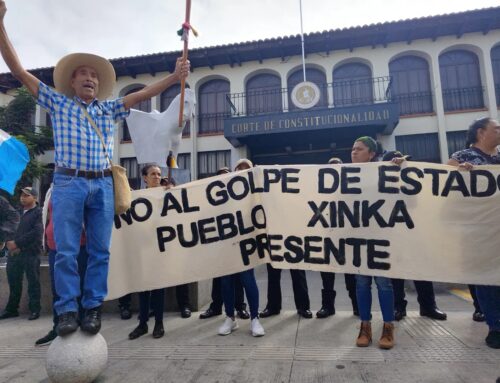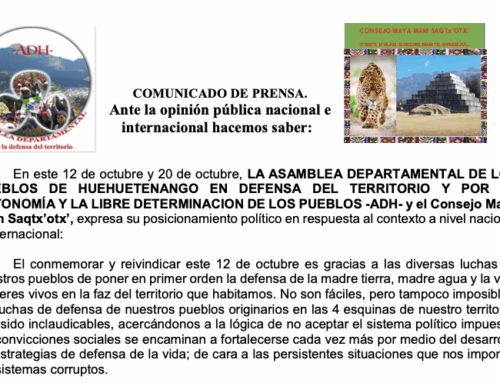The monitoring committee of the community consultation in the Ixcán writes to the public opinion, social organizations, indigenous organizations and human rights protection organizations with the purpose of informing about the situation created by the plans for the construction of the Xalalá hydro-electric dam.
Last November 7, the National Electrification Institute (INDE) signed a contract for 12 months with Brazilian company, Intertechne Consultores S.A., to undertake the geological feasibility studies of the Xalalá hydro-electric project. These studies are a preliminary requirement for the project’s construction and an offering from the government before potential investors. The awarding occurred directly, secretly and without transparency.
The Xalalá project, located at the convergence of the Chixoy and Copón rivers, dates from the 70’s and has been retaken by recent governments, from Berger to Pérez Molina, as it would be the second largest hydroelectric dam in the country. In an article published in Business News Americas – Spanish on July 17, 2012, one finds the following information provided by INDE: “Mid-way through next year there will be a call for bids on the construction of the 180 MW Xalalá hydro-electric project in Guatemala… In accordance with the information coming from INDE, geological studies are being undertaken and the Programming and Planning Secretariat (SEGEPLAN) is working on social matters related to the project, which will require close to US $350 million. The studies will end in February, while the commercial model should be defined between March and April. The latter could determine if INDE will undertake the project without help or through a public-private partnership.” However, the execution of INDE’s plans was not made by the deadline, the new objective is to begin the dam’s construction in 2014.
The invitation to bid on undertaking the “Xalalá Hydro-electric Project Geological, Geotechnical, Seismic and Geophysical Feasibility Study” was published by INDE on December 18, 2012 and was declared null and void on March 5, 2013 for the lack of offers. It is possible that the declared community opposition and nonconformity with some of the conditions weighed on the businesses that bought the terms.
Facing the bidding failure, the INDE managing council agreed, “to instruct INDE administration that, in accordance with the bidders who showed interest, in agreement with the terms of reference, and who did not participate under obligation by the management of project development, that this is a rapprochement with them without taking on any agreement, with the purpose of understanding the motives of those that did not bid and asking them about the possibility of accepting a direct invitation to present an offer to manage the study of the same project. If viable, the latter join a short list of bidders (3 bidders in agreement with the records associated with the acquisition of the terms of reference); and to define the procedure to follow, with the corresponding judicial opinion. In contrary to this possibility, to propose and recommend the course of action to be able to contract said study, with backing by the appropriate legal dictum.”
Contracting the company Intertechne Consultores S.A. took place through an emergency purchasing method and was not published in GUATECOMPRAS. According to the new purchases, contract and alienation regulation of INDE, emergency purchases and contracting is possible with the authorization of the general manager. Article 37 of the regulation says: “In emergency situations previously classified by the responsible manager, branches or businesses, the general manager will be able to authorize that urgent purchases or contracts be carried out directly to resolve the related emergency situation. For purchases that do not exceed two million quetzales (2,000,000.00), the general manager must inform the executive council within 15 days that follow; purchases exceeding two million quetzales (2,000,000.00) will require the authorization of the executive council.
It should be remembered that this new regulation was approved in March 2013, “with the purpose of accelerating the administrative paperwork of INDE’s purchasing, contracts and alienation processes and in the interest of having a larger participation in them, it is necessary to adjust and update its standards with the objective of achieving this end and so gaining a better execution”. That is, to increase the conditions’ flexibility, facilitate the contracting procedures and motivate investors. This regulation and the 2013-2027 Energy Policy were presented in the Guatemala Investment Summit forum, which took place in June of this year, as part of the offers presented by the government to promote foreign investment in hydro-electric projects.
The undertaking of the geological studies requires the presence on the ground of the contracted company’s personnel in five Q’eqchí communities where it is expected that the tunnel and retaining wall will be constructed, making bore holes up to 250 meters deep. Since the start of 2013, INDE personnel maintain strong pressure on communities and their leaders so that they permit the undertaking of the geological studies. A team of 25 developers tries to gain the trust of communities by giving gifts to children, parties, sports uniforms, helicopter trips and offering projects that are not within INDE’s capacity.
Since the start of 2013, INDE tried to meet with community leaders in Playa Grande, Cobán, and the Guatemala City. The response of the communities was to reject the invitation and ask them to arrive in the region to inform their representatives, since INDE is the party that is interested in the dam’s construction and not the communities. Finally, on November 13, a meeting took place in San Juan Chactelá between said public company and representatives of communities of the Ixcán, Zona Reyna, Uspantán and Cobán that will be directly or indirectly affected by the dam’s construction. During the meeting, the project manager and other INDE employees explained the institution’s operations, the importance of the Xalalá project and described the geological studies. On their behalf, the communities reiterated the decision expressed in the good faith community consultation and pointed out the distortion of information and the deception on the part of INDE developers. They also made them see the noncompliance of the reparations plan in the areas affected by the Chixoy dam, to whom the damage caused by the construction of the dam has not been repaired, more than 30 years later. A memorial was signed by the attending communities and supported by close to 1,500 attendees where the rejection of the construction of the Xalalá Hydro-electric Plant was reiterated.
On December 4, a meeting took place in the community of Asunción Copón, sponsored by INDE, with representatives of nine communities in the Ixcán microregions III and VI that have been developing the electrification of their communities for 11 years. Marinus Böer, general manager of INDE, and other functionaries of that institution arrived in a helicopter to speak about the comforts of electric energy, the importance of the Xalalá project and the geological study, telling community members that if they don’t accept the Xalalá dam, there will not be sufficient energy for the electrification of the communities. Despite the cooptation or deception of some leaders who lent themselves to the ploy, the position of the majority of community members was to demand electrification, which is a need that is felt in the communities, but they rejected the condition of accepting the Xalalá project, since access to electricity is a right for Guatemalans. On the part of the company, it promised to speed up the electrification project. The development coordinator of INDE repeated that through the electrification projects in the zone, they look to gain the communities’ trust.
With their lies and biased actions, INDE hopes to confuse public opinion and the communities, and at the same time promote a confrontation between the pro-electric energy committees and the organizations and communities that promote the defense of territory, who are labeled as opponents of development. The lack of electric energy in the rural communities in the north of Huehuetenango, El Quiché and Alta Verapaz, where there is less than 40% coverage, is not due to the lack of generation capacity, but rather the small investment in the rural distribution networks. The 2013 – 2027 Energy Policy, presented by the Ministry of Energy and Mines at the start of this year, notes that, “the current demand of electric power reports values close to 1,500 MW, while the Guatemalan generator park has a production capacity close to 2,700 MW”. Meanwhile, the demand for 2027 is an estimated 3,000 MW. This surplus allows Guatemala to be the largest Central American exporter of electric energy today. The same government document highlights our country’s great hydro-electric potential and presents the possibilities of increasing the generation capacity and the international market opportunities. The policies and public and private investment have prioritized electric interconnection for large consumers, which is to say the urban and industrial centers and exportation through the Central American Electrical Interconnection System (SIEPAC).
In light of the mentioned facts, the organizations and communities that form the Ixcán community consultation monitoring committee affirm that undertaking the “Xalalá Hydro-electric Project Geologic, Geotechnical, Seismic and Geophysical Feasibility Study” as contracted by INDE does not have the free, prior and informed consent of the communities where it is claimed that the study will take place and overlooks the results of the community consultations undertaken in the Ixcán (2007) and Uspantán (2009) municipalities. The imposition of government plans for the construction of mega-projects, without considering the decision and rights of the indigenous communities that will be affected could cause conflicts and confrontations, such as are occurring in Barillas and San Mateo Ixtatán (Department of Huehuetenango) and Monte Olivo, municipality of Cobán.
The strategy of making a condition of development projects, to mislead and divide communities is also a violation of the rights of indigenous people to information, to freely decide their development priorities, to a free, prior, and informed consultation and to non-discrimination. One would have to ask the INDE executives: How much has this institution spent in social studies and paying consultants who direct the “social work” of promoting the Xalalá project? How much has it cost the Guatemalan people to sustain a large team of developers, the vehicles, the constant helicopter flights, the parties and the gifts to win the trust of the communities? Why not invest this money in compensating the communities affected by the Chixoy dam? Why believe that they can continue changing indigenous people’s gold for glass beads? They have forgotten that we are neither in the times of the conquest, nor of Ubico, nor in the 80’s when our communities were massacred with impunity.
1 http://content.yudu.com/Library/A2kzvp/IntertechneNoticias4/resources/index.htm?referrerUrl=http%3A%2F%2Fwww.intertechne.com.br%2Fesp%2Findex.php%3Foption%3Dcom_content%26task%3Dview%26id%3D352%26Itemid%3D2
2 http://cmiguate.org/secretamente-inde-otorga-proyecto-de-xalala-a-empresa-brasilena/
3 CDR-084-2013. AJP-314-178-2013 OAI-110-79-2013 A-13-2013-4 Guatemala, 9 April 2013.
4 Reglamento de compras, contrataciones y enajenaciones del instituto nacional de electrificación, approved in session of 5 March 2013 by the Directive Council of INDE, act number 9-2013.
5 Idem
6 “Acuerdo Política entre el Gobierno de la República de Guatemala y los representantes de las Comunidades afectadas por la construcción de la hidroeléctrica Chixoy”, signed 10 July 2009 by the President of the Republic, Representative of COCAICH, the mediator of the OAS.
7 Ministry of Energy and Mines. Energy Policy 2013-2027, page 22.






Leave A Comment